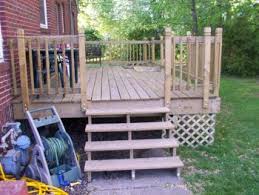Overview
Rational equations have many applications to real-world problems. Some of the types of problems that can be solved include geometric ratios, number problems, motion problems, and work problems.
Geometric Ratios
When solving geometric ratios, it helps to use the problem-solving strategy of making a sketch to check against and see if the answer makes sense. Suppose that Janet and LaToya are building a deck on the back of the house. They know that the width of the deck cannot extend back more than 3 feet, or they will be building into the neighbor’s yard. If the deck will take up 26 square feet of the backyard, what must the length be? We know that the area of the deck is 26 square feet, and since the length times the width is the area, the ratio of the area to the width will give the length. The ratio of 26/3 will give the length of 8.67 feet, or 8 feet 8 inches.
Figure 1: Building a deck uses geometric ratios.
Number Problems
Suppose that one number is 3 times another number, and the sum of their reciprocals is 5/6. What are the numbers? If x is one number, then 3x is the other number. The sum of 1/x + 1/(3x) is 6/5. If every term of the equation is multiplied by 3x to get rid of the denominator then 3 + 1 = (6/5 ∙3x), and 18/5x, or 4 = 3.6x, or x = 0.9.
Motion Problems
Suppose that it takes Devon the same amount of time to go downstream 14 miles with a current that moves at 3 miles an hour as it does to go 6 miles upstream. How fast would his canoe go in still water? The time it takes to travel in the canoe can be represented by r for rate of speed. Then r + 3 is rate downstream and r-3 is the rate upstream, against the current. The distance is 14 miles downstream and 6 miles upstream. If time = distance/rate, then the time in still water is 14/(r + 3) and 6/r – 3. Further 14/(r + 3) = 6/(r – 3). Using cross-multiplication 14(r – 3) = 6(r + 3) or 14r – 42 = 6r + 18, or 14r – 6r =18 + 42 or 8r = 60, or r = 7.5. The equations check because 14(7.5) – 42 = 6(7.5) +18
Figure 2: An example of a motion problem.
Work Problems
Suppose that Lori can weed their garden by hand in in 10 hours and Jason can weed their garden in 12 hours. How long will it take them to weed it working together? Let t equal the time worked to weed the garden by hand. Then t/10 + t/12 will equal 1 (the time it takes them to weed the entire garden). Using the LCD, then 6t + 5t = 60, or 11t = 60, 5 hrs, and 5 minutes.
Figure 3: How much time will it take 2 people to care for the garden?
Interested in algebra tutoring services? Learn more about how we are assisting thousands of students each academic year.
SchoolTutoring Academy is the premier educational services company for K-12 and college students. We offer tutoring programs for students in K-12, AP classes, and college. To learn more about how we help parents and students in Brownsville, TX: visit Tutoring in Brownsville, TX




